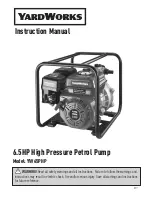
English (GB)
14
8.4 Riser pipe
If a tool, for example a chain pipe wrench, is used when the riser
pipe is fitted to the pump, the pump must only be gripped by the
pump outlet chamber.
The threaded joints on the riser pipe must all be well cut and fit
together to ensure that they do not work loose when subjected to
torque reaction caused by the starting and stopping of the pump.
The thread on the first section of the riser pipe, which is to be
screwed into the pump, must not be longer than the threads in the
pump.
When plastic pipes are used, secure the pump by an unloaded
straining wire to be fastened to the outlet chamber of the pump.
See fig.
Fig. 22
Fixing the straining wire
When connecting plastic pipes, use a compression coupling
between the pump and the first pipe section.
From 6" to 10" there is no hook or connection eye for straining
wire.
When flanged pipes are used, the flanges must be slotted to take
the submersible drop cable and a water indicator hose, if fitted.
Maximum installation pressure [mWC]
8.5 Placing in borehole
8.6 Cable clips
Fit cable clips every 3 metres to fix the submersible drop cable
and the straining wire, if fitted, to the riser pipe of the pump.
Grundfos supplies cable clip sets on request.
1. Cut off the rubber band so that the piece with no slit becomes
as long as possible.
2. Insert a button in the first slit.
3. Position the wire alongside the submersible drop cable as
shown in fig.
Fig. 23
Fitting the cable clips
4. Wind the band once around the wire and the cable. Then wind
it tightly at least twice around the pipe, wire and cable.
5. Push the slit over the button, and cut off the band.
When cables with a large cross-section are used, it will be
necessary to wind the band several times.
When plastic pipes are used, some slackness must be left
between each cable clip as plastic pipes expand when loaded.
When flanged pipes are used, the cable clips must be fitted
above and below each joint.
8.7 Lowering the pump
Grundfos recommends checking the borehole by means of an
inside calliper before lowering the pump to ensure unobstructed
passage.
Lower the pump carefully into the borehole, taking care not to
damage the motor cable and the submersible drop cable.
8.8 Installation depth
The dynamic water level must always be above the suction
interconnector of the pump. See section
and fig.
.
Minimum inlet pressure is indicated in the NPSH curve for the
pump. The minimum safety margin must be 0.5 metre head.
We recommend that you install the pump so that the motor part is
above the well screen in order to ensure optimum cooling. See
section
5.4 Liquid temperatures and motor cooling
.
When the pump has been installed to the required depth, the
installation must be finished by means of a borehole seal.
Loosen the straining wire so that it becomes unloaded and lock it
to the borehole seal by means of wire locks.
WARNING
Sharp element
Death or serious personal injury
- When mounting the riser pipe, wear personal
protective equipment to avoid cutting on sharp
edges on the pump.
Plastic pipes are recommended for 4" pumps only.
TM
00
13
68
24
20
Grundfos MS402:
150
Grundfos MS4000:
600
Grundfos MS6000:
600
Grundfos MS6000P:
300
Grundfos MMS:
600
WARNING
Crushing of hands and feet
Death or serious personal injury
- Stay clear of the wire and cable during placement
in borehole.
TM
0
0
1
36
9 5
092
DANGER
Electric shock
Death or serious personal injury
- Switch off the power supply before starting any
work on the product.
- Make sure that the power supply cannot be
accidentally switched on.
Do not lower or lift the pump by means of the motor
cable.
For pumps fitted with plastic pipes, the expansion of
the pipes when loaded must be taken into
consideration, when deciding on the installation
depth of the pump.














































